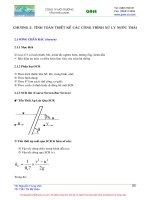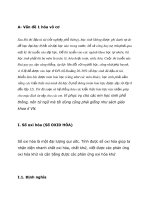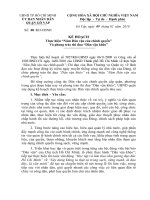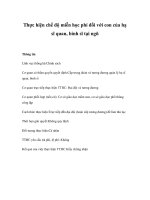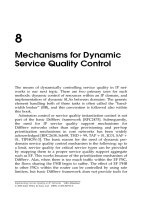Tài liệu Thực hiện tiếng nói qua IP (P2) pdf
Bạn đang xem bản rút gọn của tài liệu. Xem và tải ngay bản đầy đủ của tài liệu tại đây (1.28 MB, 17 trang )
2
TECHNOLOGIES SUPPORTING
VoIP1
In this chapter, we discuss and review various standard and emerging coding,
packetization, and transmission technologies that are needed to support voice
transmission using the IP technologies. Limitations of the current technologies
and some possible extensions or modifications to support high-quality—that is,
near-PSTN grade—real-time voice communications services using IP are then
presented.
VOICE SIGNAL PROCESSING
For traditional telephony or voice communications services, the base-band sig-
nal between 0.3 and 3.4 KHz is considered the telephone-band voice or speech
signal. This band exhibits a wide dynamic amplitude range of at least 40 dB.
In order to achieve nearly perfect reproduction after switching and transmis-
sion, this voice-band signal needs to be sampled—as per the Nyquist sampling
criteria—at more than or equal to twice the maximum frequency of the signal.
Usually, an 8 KHz (or 8000 samples per second) sampling rate is used. Each
of these samples can now be quantized uniformly or nonuniformly using a
predetermined number of quantization levels; for example, 8 bits are needed to
support 2
8
or 256 quantization levels. Accordingly, a bit stream of (8000 Â 8)
or 64,000 bits/sec (64 Kbps) is generated. This mechanism is known as the
pulse code modulation (PCM) encoding of voice signal as defined in ITU-T’s
G.711 standard [1], and it is widely used in the traditional PSTN networks.
15
1 The ideas and viewpoints presented here belong solely to Bhumip Khasnabish, Massachusetts,
USA.
Implementing Voice over IP. Bhumip Khasnabish
Copyright
2003 John Wiley & Sons, Inc.
ISBN: 0-471-21666-6
Low-Bit-Rate Voice Signal Encoding
With the advancement of processor, memory, and DSP technologies, re-
searchers have developed a large number of low-bit-rate voice signal encod-
ing algorithms or schemes. Many of these coding techniques have been stand-
ardized by the ITU-T. The most popular frame-based vocoders that utilize
linear prediction with analysis-by-synthesis are the G.723 standard [2], gen-
erating a bit stream of 5.3 to 6.4 Kbps, and the G.729 standard [3], producing
a bit stream of 8 Kbps. Both G.723 and G.729 have a few variants that sup-
port lower bit rate and/or robust coding of the voice signal. G.723 and G.723.1
coders process the voice signal in 30-msec frames. G.729 and G.729A utilize
a speech frame duration of 10 msec. Consequently, the algorithmic portion
of codec delay (including look-ahead) for G.723.1-based systems becomes
approximately 37.5 msec compared to only 15 msec for G.729A implementa-
tions. This reduction in coding delay can be useful when developing a system
where the end-to-end (ETE) delay must be minimized, for example, less than
150 msec to achieve a higher quality of voice.
An output frame of the G.723.1 coding consists of 159 bits when operating
at the 5.3 Kbps rate and 192 bits in the 6.4 Kbps option, while G.729A gen-
erates 80 bits per frame. However, the G.729A coders produce three times as
many coded output frames per second as G.723.1 implementations. Note that
the amount of processing delay contributed by an encoder usually poses more
of a challenge to the packet voice communication system designer.
Annex-B of G.729 or G.729B describes a voice or speech activity detection
(VAD or SAD) method that can be used with either G.729 or its reduced
complexity version, G.729A. The VAD algorithm enables silence suppression
and comfort noise generation (CNG). It predicts the presence of speech using
current and past statistics. G.729B allows insertion of 15-bit silence insertion
descriptor (SID) frames during the silence intervals. Although the insertion of
SID allows low-complexity processing of silence frames, it increases the e¤ec-
tive bit rate. Consequently, although in a typical conversation, suppression of
silence reduces the amount of data by almost 60%, G.729B generates a data
stream of speed of little more than 4 Kbps.
The G.729A coder-decoder (CODEC) is simpler to implement than the one
built according to the G.723.1 algorithm. Both designs utilize approximately
2K and 10K words of RAM and ROM storage, respectively, but G.729A
requires only 10 MIPS, while G.723.1 requires 16 MIPS of processing capacity.
The voice quality delivered by these CODECs is considered acceptable in
a variety of network impairment scenarios. Therefore, most VoIP product
manufacturers support G.723, G.729, and G.711 voice coding options in their
products.
Voice Signal Framing and Packetization
PSTN uses the traditional circuit switching method to transmit the voice
encoder’s output (described above) from the caller’s phone to the destination
16
TECHNOLOGIES SUPPORTING VoIP
phone. The circuit switching method is very reliable, but it is neither flexible
nor e‰cient for voice signal transmission, where almost 60% of the time the
channel or circuit remains idle [4]. This happens either because of the user’s
silence or because the user—the caller or the party called—toggles between
silence and talk modes.
In the packet switching method, the information (e.g., the voice signal) to be
transmitted is first divided into small fixed or variably sized pieces called pay-
loads, and then one or more of these pieces can be packed together for trans-
mission. These packs are then encapsulated using one or more appropriate sets
of headers to generate packets for transmission. These packets are called IP
packets in the Internet, frames in frame relay networks, ATM cells in ATM
networks [4], and so on. The header of each packet contains information on
destination, routing, control, and management, and therefore each packet can
find its own destination node and application/session port. This avoids the
needs for preset circuits for transmission of information and hence gives the
flexibility and e‰ciency of information transmission.
However, the additional bandwidth, processing, and memory space needed
for packet headers, header processing, and packet bu¤ering at the intermediate
nodes call for incorporation of additional tra‰c and resource management
schemes in network operations, especially for real-time communications ser-
vices like VoIP. These are discussed in later chapters.
In G.711 coding, a waveform coder processes the speech signal, and hence
generates a stream of numeric values. A prespecified number of these numeric
values need to be grouped together to generate a speech frame suitable for
transmission. By contrast, the G.723 and G.729 coding schemes use analysis-
synthesis algorithms-based vocoders and hence generate a stream of speech
fames, which can be easily adapted for transmission using packet-switched
networks.
As mentioned earlier, it is possible to pack one or more speech frames into
one packet. The smaller the number of voice or speech frames packed into one
packet, the greater the protocol/encapsulation overhead and processing delay.
The larger the number of voice or speech frames packed into one packet, the
greater the packet processing/storing and transmission delay. Additional net-
work delay not only causes the receiver’s playout bu¤er to wait longer before
reconstructing voice signal, it can also a¤ect the liveliness/real-timeness of a
speech signal during a telephone conversation. In addition, in real-time tele-
phone conversation, loss of a larger number of contiguous speech frames may
give the impression of connection dropout to the communicating parties. The
designer and/or network operator must therefore be very cautious in designing
the acceptable ranges of these parameters.
ITU-T recommends the specifications in G.764 and G.765 standards [5,6]
for carrying packetized voice over ISDN-compatible networks. For voice
transmission over the Internet, the IETF recommends encapsulation of voice
frames using the RTP (RFC 1889) for UDP (RFC 768)-based transfer of
information over an IP network. We discuss these in later sections.
VOICE SIGNAL PROCESSING
17
PACKET VOICE TRANSMISSION
A simple high-level packet voice transmission model is presented in this section.
The schematic diagram is shown in Figure 2-1.
At the ingress side, the analog voice signal is first digitized and packetized
(voice frame) using the techniques presented in the previous sections. One or
more voice frames are then packed into one data packet for transmission. This
involves mostly UDP encapsulation of RTP packets, as described in later sec-
tions. The UDP packets are then transmitted over a packet-switched (IP) net-
work. This network adds (a) switching, routing, and queuing delay, (b) delay
jitter, and (c) probably packet loss.
At the egress side, in addition to decoding, deframing, and depacking, a
number of data/packet processing mechanisms need to be incorporated to mit-
igate the e¤ects of network impairments such as delay, loss, delay jitter, and so
on. The objective is to maintain the real-timeness, liveliness, or interactive
behavior of the voice streams. This processing may cause additional delay.
ITU-T’s G.114 [7] states that the one-way ETE delay must be less than 150
msec, and the packet loss must remain low (e.g., less than 5%) in order to
maintain the toll quality of the voice signal [8].
Mechanisms and Protocols
As mentioned earlier, the commonly used voice coding options are ITU-
T’s G.7xx series recommendations (www.itu.int/itudoc/itu-t/rec/g/g700-799/),
Figure 2-1 A high-level packet voice transmission model.
18
TECHNOLOGIES SUPPORTING VoIP
three of which are G.711, G.723, and G.729. G.711 uses pulse code modulation
(PCM) technique and generates a 64 Kbps voice stream. G.723 uses (CELP)
technique to produce a 5.3 Kbps voice stream, and G.723.1 uses (MP-MLQ)
technique to produce a 6.4 Kbps voice stream. Both G.729 and G.729A use
(CS-ACELP) technique to produce an 8 Kbps voice stream.
Usually a 5 to 48 msec voice frame sample is encoded, and sometimes mul-
tiple voice frames are packed into one packet before encapsulating voice signal
in an RTP packet. For example, a 30 msec G.723.1 sample produces 192 bits of
payload, and addition of all of the required headers and forward error correc-
tion (FEC) codes may produce a packet size of @600 bits, resulting in a bit rate
of approximately 20 Kbps. Thus, a 300% increase in the bandwidth require-
ments may not seem unusual unless appropriate header compression mecha-
nisms are incorporated while preparing the voice signal for transmission over
the Internet.
For example, a 7 msec sample of a G.711 (64 Kbps) encoded voice produces
a 128 byte packet for VoIP application including an 18 byte MAC header and
an 8 byte Ethernet (Eth) header (Hdr), as shown in Figure 2-2. Note that the
26 byte Ethernet header consists of 7 bytes of preamble, which is needed for
synchronization, 12 bytes for source and destination addresses (6 bytes each), 1
byte to indicate the start of the frame, 2 bytes for the length indicator field, and
4 bytes for the frame check sequence.
The RTP/UDP/IP headers together add up to 20 þ 8 þ 12, or 40 bytes
of header. The IETF therefore recommends compressing the headers using a
technique (as described in RFC 1144) similar to the TCP/IP header compres-
sion mechanism. This mechanism, commonly referred to as compressed RTP
(CRTP, RFC 2508), can help reduce the header size from (12 to 40) bytes of
RTP/UDP/IP header to 2 to 4 bytes of header. This can substantially reduce
the overall packet size and help improve the quality of transmission.
Note that the larger the packet, the greater the processing, queueing,
switching, transmission, and routing delays. Thus, the total ETE delay could
become as high as 300 msec [8], although ITU-T’s G.114 standard [7] states
that for toll-quality voice, the one-way ETE delay should be less that 150 msec.
The mean opinion score (MOS) measure of voice quality is usually more sensi-
tive to packet loss and delay jitter than to packet transmission delay. Some
information on various voice coding schemes and quality degradation because
Figure 2-2 Encapsulation of a voice frame for transmission over the Internet.
PACKET VOICE TRANSMISSION
19
of transmission can be found at the following website: www.voiceage.com/
products/spbybit.htm
The specification of the IETF’s (at www.ietf.org) Internet protocol version
4 (IPv4) is described in RFC 791, and the format of the header is shown in
Figure 2-3. IP supports both reliable and unreliable transmission of packets.
The transmission control protocol (TCP, RFC 793; the header format is shown
in Figure 2-4) uses window-based transmission (flow control) and explicit
acknowledgment mechanisms to achieve reliable transfer of information. UDP
(RFC 768; the header format is shown in Figure 2-5) uses the traditional
‘‘send-and-forget’’ or ‘‘send and pray’’ mechanism for transmission of packets.
There is no explicit feedback mechanism to guarantee delivery of informa-
tion, let alone the timeliness of delivery. TCP can be used for signaling,
parameter negotiations, path setup, and control for real-time communications
like VoIP. For example, ITU-T’s H.225 and H.245 (described below) and
IETF’s domain name system (DNS) use the TCP-based communication pro-
Figure 2-3 IP version 4 (IPv4) header format. (Source: IETF’s RFC 791.)
Control Bits ) U: Urgent Pointer; A: Ack.; P: Push function; R: Reset the connection;
S: Synchronize the sequence number; F: Finish, means no more data from sender
Figure 2-4 TCP header format. (Source: IETF’s RFC 793.)
20
TECHNOLOGIES SUPPORTING VoIP
